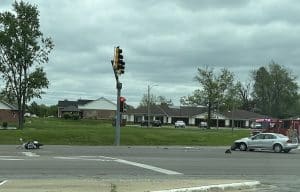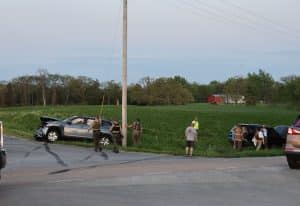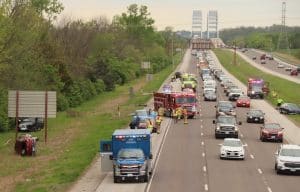Main Street Abbey plans taking shape
Nearly 50 people packed the back room of Aunt Maggie’s on Main in Columbia Monday to hear the latest on plans to convert the former Immaculate Conception Catholic Church, convent and rectory into an event space with high-end lofts, and eventually turn the grade school into a garden restaurant, micro-brewery, bed and breakfast and meeting rooms.
The project is the vision of Columbia real estate agent and developer Gregg Crawford, who is no stranger to ambitious Columbia Main Street projects.
“Basically this project started about 10 years ago,” Crawford said, recounting a trip to Portland, Oreg., where he and his wife happened upon a similar project called Kennedy School.
“Ten years ago, we stayed at a place called Kennedy School. It’s laid out exactly like the ICS property lays out and I said, ‘If (ICS) would ever come available, I think this would be something that would go over well here in town.’
Pictured, from left, Immaculate Conception Catholic Parish’s Father Carl Scherrer, Columbia real estate agent Gregg Crawford and Columbia Mayor Kevin Hutchinson explain to about 60 people plans to save and re-purpose the de-consecrated Immaculate Conception Church, convent, rectory and, eventually, school, with the use of TIF funds.“Well, low and behold, it became available.”
Crawford’s concept includes turning the existing church into an event center — a place that can host a wedding and reception on site at the same location.
“Instead of people having their weddings (in Columbia) and going over to St. Louis to spend their money over there, we’d like to see them spend it right here in town,” Crawford said.
Improvement would include ADA-compliant restrooms, a warming kitchen and more — “a complete refresh.”
“There’s not going to be a lot of exterior changes. There will be some, but I don’t want to change the look,” he said.
Crawford is not new to Columbia’s Main Street. From the historic Vogt building, which his Concept Realty currently occupies, to the Old Distillery Center, as well as Reifschneider’s Grill & Grape, Joe’s Pizza, Vapor Warehouse and the old Mini Mart that is now Fashion Attic, Crawford’s love is identifying historic spaces, renovating them and renting them out to businesses he sees as offering a good fit for both the space and community. He even designed the inside of The Falls, which some might think offers a conflict of interest but which Crawford and The Falls Reception & Conference Center manager Kip Queveraux see as nothing but beneficial to Columbia and each other.
“I want to mention that Gregg was instrumental in The Falls when we built The Falls,” Queveraux said. “Gregg and his company did all the interior work. He’s wonderful to work with, and he doesn’t do anything half(way). I think he’s going to do a phenomenal job on whatever he touches.”
Queveraux offered the comparison that when new car dealership Brockland opened its doors across the street from George Weber Chevrolet, Weber noted a spike in business. As the north end of Columbia is becoming a destination for car buyers, in the eyes of Queveraux and Crawford, downtown Columbia can become a destination for receptions and events.
But Crawford’s project involves much more than an event space in the de-consecrated Immaculate Conception Catholic Church. He also has big plans for the rectory and convent, including one and two bedroom high-end lofts. For the school building, arguably the biggest element of the project, he envisions a bed and breakfast with the old classrooms converted into quaint lodgings, as well as a micro-brewery in the gym and a restaurant with garden area in the cafeteria.
Crawford plans to begin work on the church building, rectory and convent immediately, and would like to see them at least partially open for business by about November. The school, which is still in use, is on a longer timetable. And all elements of the project will require a large amount of work, which equals a large amount of money.
“Gregg has never asked the city for TIF money for any of the other Main Street projects he’s been involved with,” said Columbia Mayor Kevin Hutchinson.
But, by all accounts, this project is different.
There are significant infrastructure upgrades necessary for this area which, without a large-scale project as proposed by Crawford, would likely remain underperforming and unproductive, both of which mean producing little tax revenue for the city.
For this reason, Crawford is seeking tax increment financing assistance from the city. But first, Crawford and city leaders are seeking to educate the voting, tax-paying public about what TIF is and what TIF is not.
“A lot of times when businesses come in and they know they are going to have a lot of expenses that aren’t typical but they’re going to develop a lot of other taxes that are going to assist the community, we (as a city) start looking at the tools that we have available, and (one) of those tools is tax increment financing, which is centered around the property tax.” Hutchinson said.
When TIF-eligible re-development is planned, the value of the property, before it is improved, is established. It is from this “base” valuation that taxing bodies like schools and emergency services are paid their tax revenue.
As the area is improved and the property value increases, the amount above that base established at the beginning is paid into a special fund that is then used for things like infrastructure including roads, sewers and sidewalks, rehabilitating historic projects, improving downtown business districts, and more, thereby increasing the value of the property even more, for a period of time set out in the initial TIF agreement — a maximum of 23 years per Illinois statute. When the TIF period ends, the higher property value, and with it the higher property tax, goes into the regular coffers of city, school and other relevant taxing districts.
In short, Hutchinson emphasized, “There is no citizen money in TIF. But with these tools TIF provides, we’re going to be able to maintain the high quality Columbia has, sustain it and make it grow.”
Immaculate Conception Church successfully closed on the sale of its Main Street property to Main Street Redevelopment, owned by Gregg and Jane Crawford, at the end of January. The church is leasing back the school from Main Street Redevelopment as its works toward a new educational center at the new church site on Palmer Road.
For more information on the Main Street Abbey project, visit www.MainStreetAbbey.com or www.ColumbiaIllinois.com.






